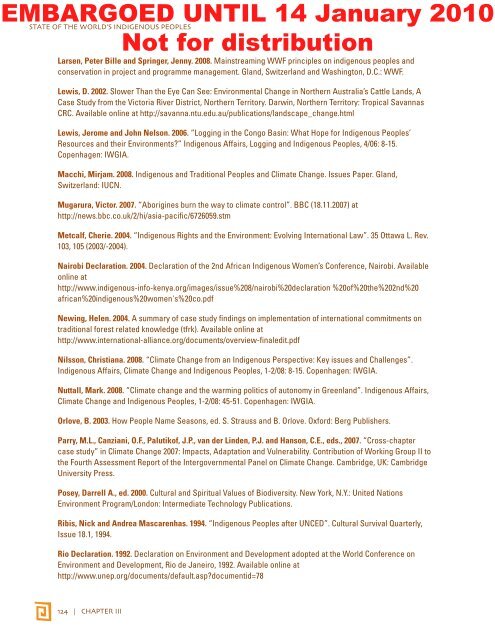STATE OF THE WORLD's INDIGENOUs PEOpLEs - CINU
STATE OF THE WORLD's INDIGENOUs PEOpLEs - CINU
STATE OF THE WORLD's INDIGENOUs PEOpLEs - CINU
- No tags were found...
Create successful ePaper yourself
Turn your PDF publications into a flip-book with our unique Google optimized e-Paper software.
EMBARGOED UNTIL 14 January 2010<strong>STATE</strong> <strong>OF</strong> <strong>THE</strong> WORLD’S INDIGENOUS PEOPLESNot for distributionLarsen, Peter Bille and Springer, Jenny. 2008. Mainstreaming WWF principles on indigenous peoples andconservation in project and programme management. Gland, Switzerland and Washington, D.C.: WWF.Lewis, D. 2002. Slower Than the Eye Can See: Environmental Change in Northern Australia’s Cattle Lands, ACase Study from the Victoria River District, Northern Territory. Darwin, Northern Territory: Tropical SavannasCRC. Available online at http://savanna.ntu.edu.au/publications/landscape_change.htmlLewis, Jerome and John Nelson. 2006. “Logging in the Congo Basin: What Hope for Indigenous Peoples’Resources and their Environments?” Indigenous Affairs, Logging and Indigenous Peoples, 4/06: 8-15.Copenhagen: IWGIA.Macchi, Mirjam. 2008. Indigenous and Traditional Peoples and Climate Change. Issues Paper. Gland,Switzerland: IUCN.Mugarura, Victor. 2007. “Aborigines burn the way to climate control”. BBC (18.11.2007) athttp://news.bbc.co.uk/2/hi/asia-pacific/6726059.stmMetcalf, Cherie. 2004. “Indigenous Rights and the Environment: Evolving International Law”. 35 Ottawa L. Rev.103, 105 (2003/-2004).Nairobi Declaration. 2004. Declaration of the 2nd African Indigenous Women’s Conference, Nairobi. Availableonline athttp://www.indigenous-info-kenya.org/images/issue%208/nairobi%20declaration %20of%20the%202nd%20african%20indigenous%20women's%20co.pdfNewing, Helen. 2004. A summary of case study findings on implementation of international commitments ontraditional forest related knowledge (tfrk). Available online athttp://www.international-alliance.org/documents/overview-finaledit.pdfNilsson, Christiana. 2008. “Climate Change from an Indigenous Perspective: Key issues and Challenges”.Indigenous Affairs, Climate Change and Indigenous Peoples, 1-2/08: 8-15. Copenhagen: IWGIA.Nuttall, Mark. 2008. “Climate change and the warming politics of autonomy in Greenland”. Indigenous Affairs,Climate Change and Indigenous Peoples, 1-2/08: 45-51. Copenhagen: IWGIA.Orlove, B. 2003. How People Name Seasons, ed. S. Strauss and B. Orlove. Oxford: Berg Publishers.Parry, M.L., Canziani, O.F., Palutikof, J.P., van der Linden, P.J. and Hanson, C.E., eds., 2007. “Cross-chaptercase study” in Climate Change 2007: Impacts, Adaptation and Vulnerability. Contribution of Working Group II tothe Fourth Assessment Report of the Intergovernmental Panel on Climate Change. Cambridge, UK: CambridgeUniversity Press.Posey, Darrell A., ed. 2000. Cultural and Spiritual Values of Biodiversity. New York, N.Y.: United NationsEnvironment Program/London: Intermediate Technology Publications.Ribis, Nick and Andrea Mascarenhas. 1994. “Indigenous Peoples after UNCED”. Cultural Survival Quarterly,Issue 18.1, 1994.Rio Declaration. 1992. Declaration on Environment and Development adopted at the World Conference onEnvironment and Development, Rio de Janeiro, 1992. Available online athttp://www.unep.org/documents/default.asp?documentid=78124 | CHAPTER III
















